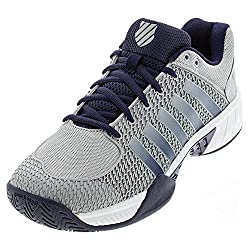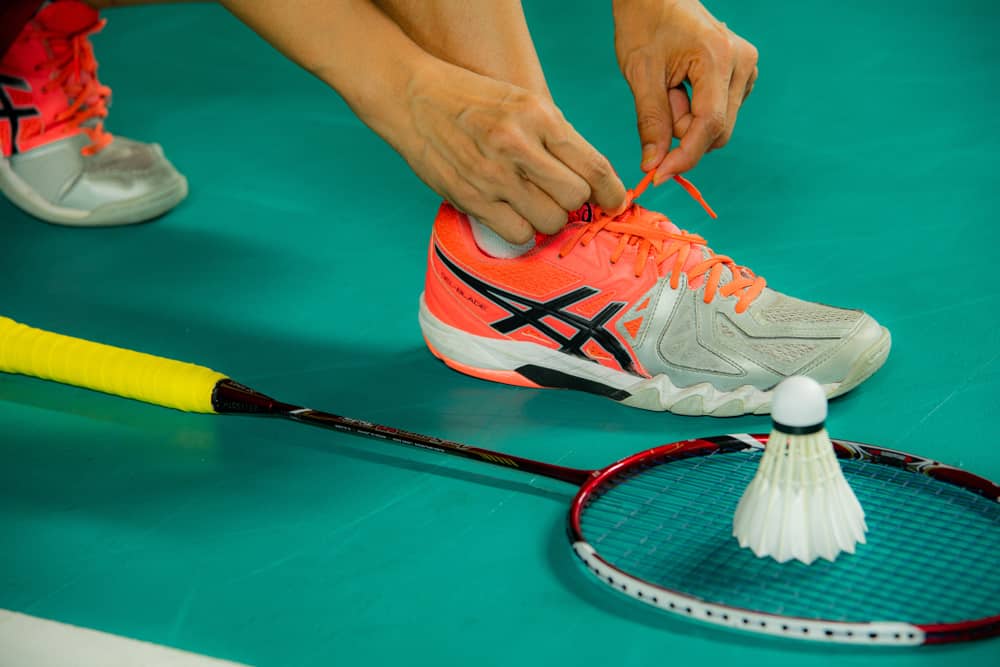Rubber shoes are used by badminton players when playing on artificial or wooden courts. The players need to move frequently, move quickly, and stop suddenly. The rubber shoes help tremendously with these movements. But, there is more to it than that. So why do badminton players wear rubber shoes and only rubber shoes?
Badminton players use rubber shoes primarily for better traction. Badminton courts are unique surfaces and rubber shoes with rubber outsoles provide the proper friction for lateral movement, especially on a badminton court. Rubber shoes also provide players with great flexibility and ankle support.
In this article, I’ll discuss the difference between badminton shoes and regular shoes. I’ll also explain why rubber shoes are important and what to look for in rubber shoes. Keep reading to learn more.
The Beginner Badminton Racquet I Recommend
New to badminton? Click here if you’re wondering why badminton can be such a hard sport.
Badminton Shoe Key Features
The characteristics and key features of badminton shoes are why badminton players choose rubber shoes. The key features of a great badminton shoe are as follows:
- Lightweight
- Ankle movement
- Gum rubber
- Cushioning
- Breathability and moisture control
- Non-marking
Now I’ll break down each of these 6 key features so you can better understand why each aspect is ideal for badminton.
Lightweight
Badminton shoes need to be lightweight because badminton is a fast-paced sport, and the player needs to change direction frequently. Heavy shoes can be burdensome for the players as they move about the court.
Ankle Movement
A badminton shoe should not cover the ankle to protect it from being injured.
Due to the many directions a badminton player must move in, the ankle should be left free to move and adapt to each move the player makes. With ankle protection, your movements could be hindered in the long term, slowing the player down in the process.
Gum Rubber
Gum rubber is the ideal material for the soles of badminton shoes. This material provides the shoe with a significant amount of traction needed for the sudden movements made on the badminton court.
The pattern of the sole is not as important as the material of the sole, so for the best results, ensure that gum rubber is the material used. Gum rubber is typically yellow to orange-yellow.
Ergonomic Shape
This is a specialized design that provides incredible comfort to the forefoot and toes. It gives the feet, ankles, and toes equilibrium. In addition, the ergo shape enhances stability and flexibility at the toes and forefoot area.
Cushioning
Cushioning is essential against impact, as it acts as a shock absorber. Badminton is a very aggressive racket sport, with drastic changes in direction, dashing, and jumps. Therefore, proper cushioning will reduce the impact on the knees of the players, reducing the risk of injury.
Breathability & Moisture Control
Sweat is produced while playing badminton, as with any other high-intensity sport. The shoes should offer adequate breathability and moisture control to prevent bad odor and excess sweat.
Double Russel Mesh equips the shoes with enhanced air exchange, which decreases the chances of sweat collecting around the feet.
Non-Marking Soles
This feature has no direct impact on the player’s ability or well-being, but the rubber shoes must be non-marking on the majority of badminton courts. Non-marking shoes ensure the court is not damaged due to marks from the soles.
Badminton Shoes vs Other Court Shoes
Before we go any further, I feel the need to clarify a few things for you. First off, badminton shoes are indeed “court shoes” but not like the court shoes you’d wear for sports like tennis or pickleball.
Not every court shoe has a rubber outsole. In fact, most don’t. That’s what makes badminton shoes, true badminton shoes, unique.

Other court shoes, like court shoes for tennis, are designed for rougher outdoor surfaces. So, they don’t have rubber, grippy outsoles.
Could you wear them for badminton? Yes, for recreation play. But that’s about all. If you play badminton more than once a month, I recommend getting a dedicated pair of rubber court shoes for badminton.
Need a suggestion? Try the Sonicage 2 by the premier brand in Badminton – Yonex. It’s a great-looking badminton shoe that’s lighter than the Sonicage 1 and is extremely affordable.
The Difference Between Badminton Shoes and Other Regular Shoes
The material and thickness of the soles, flexibility, and support are the main differences between badminton shoes and regular shoes. By “regular shoe”, I mean any other type of athletic shoe that someone might consider playing badminton in.
This could include running shoes, walking shoes, or other cross-trainers for everyday use.
Related: Check out my guide on if badminton shoes make good running shoes.
Now, let’s discuss each difference in more detail below:
Soles
The soles of badminton shoes and regular shoes are manufactured for entirely different reasons. This is the reason the thickness and the material of the sole differ.
Thickness
The sole thickness of a regular shoe is greater and more enduring than that of badminton shoes.
While playing badminton, very explosive movements are required. The more you feel the floor beneath you, the more explosive your movement will be. Therefore, a thinner sole allows the player to feel more of the floor.
Thick soles are designed for regular shoes to reduce the likelihood of your feet hurting when moving around in them for prolonged periods. They prevent the foot from feeling too much of the ground beneath them.
Thickness also impacts the center of gravity. Badminton shoes are flatter without elevated soles. This provides the badminton player with a lower center of gravity, delivering enhanced balance and stability.
Material
Although regular and badminton shoes are made from rubber, there is a difference. Badminton shoes are manufactured using gum rubber, while regular shoes use normal rubber.
Gum rubber is thinner, softer, and more flexible, allowing freedom of movement on the badminton court. Regular shoes use normal rubber because they need to be durable for the outdoors as well.

Flexibility
Badminton shoes are far more flexible than regular shoes. This is because the movement in badminton is fast-paced, extremely varied, and explosive.
The shoes need to configure around the shape of the foot for each movement. Therefore, the flexibility of the shoe allows the movements to be made faster.
The movement for regular shoes is generally straightforward and similar. There is a minimal sudden change of direction when wearing regular shoes, so flexibility is not a requirement.
Support
Badminton shoes are designed to offer superb lateral support. This is because badminton requires a lot of side-to-side movement, and the shoes provide additional material to the sides to deliver that extra support to that area of the player’s feet.
Ankle injuries are one of the most common injuries in badminton. However, this additional support reduces the chance of sprains.
Regular shoes do not have extra material to support the sides of the foot, as lateral movement is not a natural movement in everyday life.
Why Do Badminton Players Wear Rubber Shoes – Conclusion
So, why do badminton players wear rubber shoes? In short, to enhance their performance with additional traction, extra cushion, flexibility, and support. The rubber shoes should be manufactured from gum rubber to improve the center of gravity, comfort, and explosive movements.
When selecting rubber shoes, ensure that they are lightweight, allow for ankle movement, have an ergo shape and extra cushioning, are breathable with moisture control, and are non-marking.
All of these play some role in the performance and well-being of the player, except for non-marking, as this is simply a requirement to play on most courts.

Welcome to TheVolleyLlama.com. My name is Keith, I’m just a lover of all sports that involve a racquet, net and a ball. I played competitive high school varsity tennis, love racquetball and my whole family plays pickleball regularly. I started this website to help give people like you the basics to learn these wonderful games.


